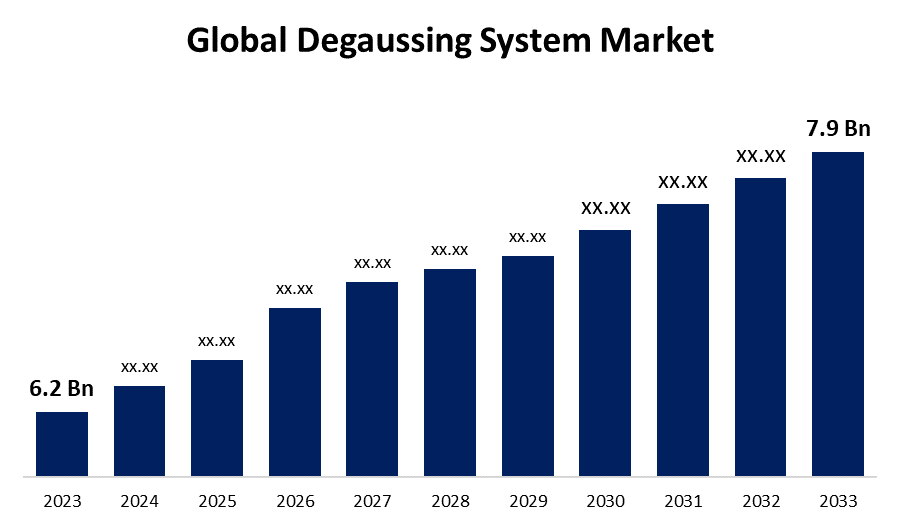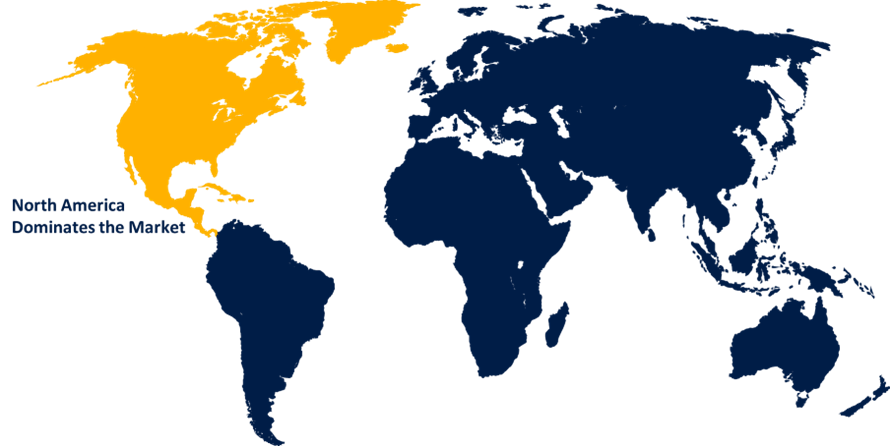Global Degaussing System Market Size, Share, and COVID-19 Impact Analysis, By Solution (Ranging, Degaussing, and Deperming), By Vessel Type (Small Vessel (< 100 M), Medium Vessel (100-200 M), and Large Vessel (>200 M)), By End User (Services, OEM, and Aftermarket), and By Region (North America, Europe, Asia-Pacific, Latin America, Middle East, and Africa), Analysis and Forecast 2023 - 2033
Industry: Aerospace & DefenseGlobal Degaussing System Market Insights Forecasts to 2033
- The Degaussing System Market Size was valued at USD 6.2 Billion in 2023.
- The Market Size is growing at a CAGR of 2.45% from 2023 to 2033.
- The Worldwide Degaussing System Market is expected to reach USD 7.9 Billion by 2033.
- Asia Pacific is expected to grow the fastest during the forecast period.

Get more details on this report -
The Global Degaussing System Market Size is expected to reach USD 7.9 billion by 2033, at a CAGR of 2.45% during the forecast period 2023 to 2033.
The degaussing system market is driven by increasing naval defense investments and the rising need to reduce electromagnetic signatures in naval vessels. These systems help minimize magnetic interference, preventing detection by enemy mines and submarines. Growth in the market is fueled by advancements in automation, sensor technology, and AI-based monitoring. Key end-users include naval forces, shipbuilders, and commercial shipping companies. North America and Europe dominate the market due to significant defense budgets, while the Asia-Pacific region is witnessing rapid growth with increasing maritime security concerns. Major players focus on R&D to enhance system efficiency and integration capabilities. However, high initial costs and maintenance challenges pose restraints. Overall, the market is expected to expand steadily, driven by technological advancements and global security concerns.
Degaussing System Market Value Chain Analysis
The degaussing system market value chain comprises raw material suppliers, component manufacturers, system integrators, and end-users. Raw material suppliers provide essential components like electromagnetic coils, sensors, and control units. Component manufacturers assemble these parts into functional modules, ensuring compliance with defense and maritime standards. System integrators, including major defense contractors and shipbuilders, design, test, and install degaussing systems in naval and commercial vessels. End-users primarily include naval forces, coast guards, and commercial shipping companies seeking to minimize electromagnetic signatures. Aftermarket services such as system upgrades, maintenance, and technical support play a crucial role in sustaining operational efficiency. The market is driven by technological advancements, with automation and AI-based monitoring enhancing system performance, while stringent defense regulations and high costs pose challenges.
Degaussing System Market Opportunity Analysis
The degaussing system market presents significant opportunities driven by rising global security concerns and increasing naval defense spending. As maritime threats evolve, the demand for advanced degaussing solutions to minimize vessel detectability is growing. The increasing use of AI and automation in system design offers opportunities for innovation and higher efficiency in degaussing technology. Additionally, the expansion of commercial shipping fleets, especially in emerging markets like Asia-Pacific, is creating demand for cost-effective degaussing solutions. With maritime security becoming a priority, governments are investing in upgrading naval fleets and modernizing degaussing systems. Moreover, growing environmental concerns over traditional anti-mining systems create opportunities for eco-friendly and advanced degaussing technologies. Overall, the market offers strong growth potential in both defense and commercial sectors, along with a push for technological advancements.
Global Degaussing System Market Report Coverage
| Report Coverage | Details |
|---|---|
| Base Year: | 2023 |
| Market Size in 2023: | USD 6.2 Billion |
| Forecast Period: | 2023 – 2033 |
| Forecast Period CAGR 2023 – 2033 : | 2.45% |
| 023 – 2033 Value Projection: | USD 7.9 Billion |
| Historical Data for: | 2019-2021 |
| No. of Pages: | 230 |
| Tables, Charts & Figures: | 99 |
| Segments covered: | By Solution, By Vessel Type, By End User, By Region |
| Companies covered:: | Wartsila Larsen & Turbo Limited Ultra Electronics Holdings plc L3Harris Technologies Inc American Superconductor Corporation Polyamp AB ECA Group STL Systems AG DA Group IFEN SPA |
| Pitfalls & Challenges: | COVID-19 Empact,Challenges, Future, Growth, & Analysis |
Get more details on this report -
Market Dynamics
Degaussing System Market Dynamics
The increasing focus on marine surveillance is propelling market growth
The increasing focus on marine surveillance is driving the growth of the degaussing system market. As naval forces and commercial shipping companies enhance their surveillance capabilities, the need for advanced degaussing solutions to reduce vessel detectability is rising. Governments worldwide are investing in modernizing naval fleets to counter evolving maritime threats, further boosting demand for degaussing systems. Additionally, technological advancements such as AI-driven monitoring and automation are improving system efficiency, making them more attractive to defense and commercial sectors. The growing geopolitical tensions and the need for enhanced maritime security are prompting increased spending on degaussing solutions. Emerging markets, particularly in Asia-Pacific, are witnessing rapid adoption due to expanding naval operations. Overall, the market is poised for steady growth, driven by heightened marine surveillance efforts.
Restraints & Challenges
High initial costs and complex installation processes make adoption difficult, especially for smaller naval forces and commercial shipping companies. Maintenance and operational challenges, including system calibration and periodic upgrades, add to overall expenses. Additionally, strict regulatory standards and defense compliance requirements can slow down system implementation. The market also faces technological challenges, as integrating degaussing systems with modern automated naval platforms requires advanced engineering and expertise. Furthermore, budget constraints in certain regions limit defense spending, affecting procurement rates. The presence of alternative stealth technologies may also impact market growth.
Regional Forecasts
North America Market Statistics

Get more details on this report -
North America is anticipated to dominate the Degaussing System Market from 2023 to 2033. The United States, with its large naval fleet and focus on maritime security, is the key contributor to market growth. The U.S. Navy continuously upgrades its degaussing systems to enhance stealth capabilities and reduce electromagnetic signatures, fueling demand for advanced solutions. Additionally, the presence of major defense contractors and system integrators accelerates innovation and deployment. Canada is also investing in naval modernization programs, further supporting market expansion. Stringent defense regulations and cybersecurity concerns are shaping market trends, leading to increased adoption of AI-driven and automated degaussing technologies. Overall, North America’s strong defense budget and focus on naval superiority position it as a leading market for degaussing systems.
Asia Pacific Market Statistics
Asia Pacific is witnessing the fastest market growth between 2023 to 2033. China, India, Japan, and South Korea are heavily investing in advanced naval technologies to counter regional threats and enhance stealth capabilities. Expanding naval fleets and growing geopolitical tensions in the South China Sea and the Indian Ocean are further accelerating demand for degaussing systems. Governments in the region are focusing on reducing vessel detectability and enhancing electromagnetic signature control to improve defense readiness. Additionally, technological advancements and collaborations with global defense contractors are fostering market expansion. However, budget constraints in some developing nations and complex system integration remain challenges. Overall, Asia-Pacific presents significant growth opportunities for the degaussing system market, driven by increasing defense expenditures and strategic military initiatives.
Segmentation Analysis
Insights by Solution
The degaussing segment accounted for the largest market share over the forecast period 2023 to 2033. Naval forces worldwide are prioritizing electromagnetic signature reduction to counter advanced detection technologies used by adversaries. This has led to rising investments in automated and AI-powered degaussing solutions for improved efficiency and real-time monitoring. The segment is also benefiting from ship modernization programs, particularly in defense-heavy regions like North America, Europe, and Asia-Pacific. Additionally, advancements in materials and sensor technologies are enhancing system performance, driving adoption. However, high installation costs and maintenance challenges pose constraints. Despite this, the growing focus on maritime security and the expansion of commercial shipping fleets are expected to fuel the continued growth of the degaussing segment.
Insights by Vessel Type
The medium vessel (100-200 m) segment accounted for the largest market share over the forecast period 2023 to 2033. This vessel category, including frigates, patrol boats, and cargo ships, is increasingly focused on enhancing electromagnetic signature management for improved stealth and protection against modern detection systems. As maritime security concerns rise, naval forces are prioritizing the installation of degaussing systems to safeguard these medium-sized vessels from threats like mines and submarines. Additionally, commercial shipping companies are investing in degaussing systems to ensure compliance with environmental and regulatory standards. The integration of AI-based monitoring and automation technologies is further improving system performance, making degaussing systems more appealing to this segment. Overall, the growing emphasis on maritime security and fleet modernization is expected to drive continued growth in this segment.
Insights by End User
The OEM segment accounted for the largest market share over the forecast period 2023 to 2033. The growth is driven by increasing demand for advanced, integrated degaussing solutions in naval and commercial vessels. Shipbuilders and defense contractors are partnering with OEMs to develop customized, high-performance degaussing systems that meet stringent military and maritime regulations. The rise in naval modernization programs, particularly in North America, Europe, and Asia-Pacific, is further boosting OEM demand. Additionally, advancements in automation, AI-driven monitoring, and lightweight materials are enhancing system efficiency, leading to increased adoption. OEMs are also focusing on R&D to improve cost-effectiveness and reliability. However, high initial investment and complex integration processes remain challenges. Despite this, the growing need for stealth capabilities and electromagnetic protection is expected to drive sustained OEM segment growth.
Recent Market Developments
- In January 2022, According to Capt. Seth Miller, program manager for the Arleigh Burke class, the U.S. Navy is contemplating the installation of enhanced degaussing technology on all destroyers by 2023.
Competitive Landscape
Major players in the market
- Wartsila
- Larsen & Turbo LimitedUltra Electronics Holdings plc
- L3Harris Technologies Inc
- American Superconductor Corporation
- Polyamp AB
- ECA Group
- STL Systems AG
- DA Group
- IFEN SPA
Market Segmentation
This study forecasts revenue at global, regional, and country levels from 2023 to 2033.
Degaussing System Market, Solution Analysis
- Ranging
- Degaussing
- Deperming
Degaussing System Market, Vessel Type Analysis
- Small Vessel (< 100 M)
- Medium Vessel (100-200 M)
- Large Vessel (>200 M)
Degaussing System Market, End User Analysis
- Services
- OEM
- Aftermarket
Degaussing System Market, Regional Analysis
- North America
- US
- Canada
- Mexico
- Europe
- Germany
- Uk
- France
- Italy
- Spain
- Russia
- Rest of Europe
- Asia Pacific
- China
- Japan
- India
- South Korea
- Australia
- Rest of Asia Pacific
- South America
- Brazil
- Argentina
- Rest of South America
- Middle East & Africa
- UAE
- Saudi Arabia
- Qatar
- South Africa
- Rest of the Middle East & Africa
Frequently Asked Questions (FAQ)
-
1. What is the market size of the Degaussing System Market?The global Degaussing System Market is expected to grow from USD 6.2 billion in 2023 to USD 7.9 billion by 2033, at a CAGR of 2.45% during the forecast period 2023-2033.
-
2. Who are the key market players of the Degaussing System Market?Some of the key market players of the market are Wartsila; Larsen & Turbo Limited; Ultra Electronics Holdings plc; L3Harris Technologies Inc; American Superconductor Corporation; Polyamp AB; ECA Group; STL Systems AG; DA Group; IFEN SPA.
-
3. Which segment holds the largest market share?The OEM segment holds the largest market share and is going to continue its dominance.
-
4. Which region dominates the Degaussing System Market?North America dominates the Degaussing System Market and has the highest market share.
Need help to buy this report?